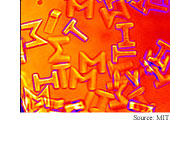|
NEWS
|
Virus-built
batteries
A thin film assembled
by viruses contains gold-cobalt oxide nanowires that
can serve as electrodes for lithium ion batteries. The
technique could lead to thin, flexible batteries for powering
flexible electronic devices like electronic paper. (Virus-Enabled
Synthesis and Assembly of Nanowires for Lithium Ion Battery
Electrodes, Science, published online April 6, 2006)
Micro plastic assembly line

A technique for making minuscule
plastic objects uses flashes of light to pattern and
harden liquid plastic flowing through tiny channels. The
technique could be used to quickly and inexpensively make
photonic chips, micromechanical devices and biocompatible
particles for drug delivery and disease diagnosis. (Continuous
Flow Lithography for High-Throughput Microparticle Synthesis,
Nature Materials, published online April 9, 2006)
Thumbnail document browser
A method for navigating
documents fills the screen with thumbnails of every
page, magnifies the thumbnail below the cursor and highlights
the thumbnail of the most recently viewed page. The technique
is faster and easier to use than scrolling. (Faster Document
Navigation with Space-Filling Thumbnails, Computer-Human
Interaction (CHI) 2006, April 22-28, Montréal, Canada)
All hands on desk
A hand
gesture interface for a tabletop display taps group
cooperation to carry out commands like clearing the screen
and sizing images. (Cooperative Gestures: Multi-User Gestural
Interactions for Co-located Groupware, Computer-Human
Interaction (CHI) 2006, April 22-28, Montréal, Canada)
Liquid silicon
A liquid
chemical process for making transistors from the polycrystalline
form of silicon opens the way for inkjet printing of high-speed
circuitry. The technique could hasten the arrival of flexible
electronic devices like large-area displays. (Solution-Processed
Silicon Films and Transistors, Nature, April 6, 2006)
Blood typing biochip
A disposable
plastic biochip determines blood type within three
minutes. The device promises to speed and simplify the
process of matching donors and recipients. (Disposable
Integrated Microfluidic Biochip for Blood Typing by Plastic
Microinjection Molding, Lab on a Chip, published online
April 4, 2006)
|
FEATURES
|
View
from the High Ground: Cornell's Jon Kleinberg
Six degrees of separation, buying gasoline
by the molecule, the science of popularity, all just getting
along online, intellectual prosthetics, Big Science, making
up questions, and telling stories.
|
How
It Works: Quantum computing: qubits
Photons, electrons and atoms, oh my! These particles are
the raw materials for qubits, the basic building blocks
of quantum computers. |
|
 |
News RSS feed 
Blog RSS feed 
Bookshelf RSS feed

New: TRN's
Internet Services
TRN's Jobs Center
|
| |
|
| |
|
| |
"In
most areas of science and technology, the origins
of new breakthroughs can still be found in the work
of a small number of people -- or even a single
person -- working at their own pace on their own
questions, pursuing things that interest them. "
- Jon Kleinberg, Cornell University |
|
| |
|
| |
Thanks
to Kevin from
GoldBamboo.com
for technical support |
|

